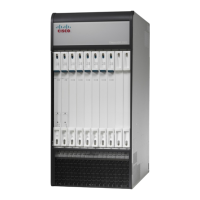Viewing the Address Resolution Protocol Table
The system provides a mechanism for viewing Address Resolution Protocol (ARP) table information to a
specific node or for an entire context. This information can be used to verify that when the system sends an
ARP packet, it receives valid responses from other network nodes.
[local]host_name# show ip arp [ arp_ip_address ]
arp_ip_address specifies a specific network node for which to display ARP information. The address can be
entered in IPv4 dotted-decimal or IPv6 colon-separated-hexadecimal notation. If this keyword is not specified,
all entries within the context's ARP table are displayed.
Restarting the VPN Manager removes all interfaces from the kernel which in turn removes all ARP entries.
However, the NPU still retains all of the ARP entries so that there is no traffic disruption. From a user
point of view, show ip arp is broken since this command gathers information from the kernel and not the
NPU.
Important
The following displays a sample of this command's output showing a context's ARP table.
Flags codes:
C - Completed, M - Permanent, P - Published, ! - Not answered
T - has requested trailers
Address Link Type Link Address Flags Mask Interface
10.0.4.240 ether 00:05:47:02:20:20 C MIO1
10.0.4.7 ether 00:05:47:02:03:36 C MIO1
10.0.4.1 ether 00:01:30:F2:7F:00 C MIO1
Using the System Diagnostic Utilities
The system provides protocol monitor and test utilities that are useful when troubleshooting or verifying
configurations. The information generated by these utilities can help identify the root cause of a software or
network configuration issue.
This section describes how to use these utilities.
Only an administrator with Operator or higher privilege can run the diagnostic utilities described in this
section.
Important
Using the Monitor Utility
For troubleshooting purposes, the system provides a protocol monitoring utility. This tool displays protocol
information for a particular subscriber session or for every session being processed.
The monitor tool may cause session processing delays and/or data loss. Therefore, it should be used only
when troubleshooting.
Caution
ASR 5500 System Administration Guide, StarOS Release 21.5
162
Troubleshooting
Viewing the Address Resolution Protocol Table

